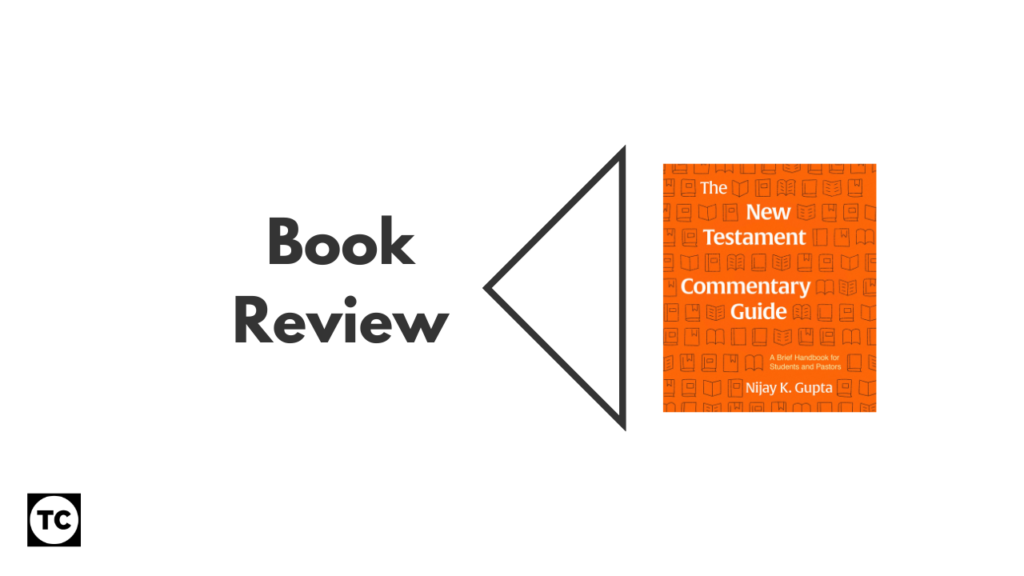
As well as reading and reviewing commentaries for fun, regular readers will know that I’ve got the daunting privilege of serving as the in-house editor for most of IVP/Apollos’s series. That means I’m regularly engaging with not just commentaries, but related tools, and that even more niche thing: reviews of commentaries or guides to commentaries. I’m a fan of bestcommentaries.com, and I’ve got the most recent edition of Carson and Longman’s NT/OT commentary surveys. I was interested, then that the latest ‘Logos Free Book of the Month’ was Nijay Gupta’s ‘The New Testament Commentary Guide: A Brief Handbook for Students and Pastors’ – a short book that (published in 2020) seeks to give an overview of the ballooning field of New Testament commentaries.
The book is divided into two broad parts – firstly, an introduction to the major series. It’s worth noting that by and large the bulk of the words here are the series’ own self-descriptions, but Gupta helpfully adds a few descriptors that make it a useful guide for building a library: level, theological orientation, methods, pricing, and a brief note. The only way this part of the book could have been improved is if Gupta had perhaps laid his own cards on the table in terms of churchmanship/theology, and used his own commentaries (Which, up until 2020, are listed as an appendix) as examples. Otherwise, it’s good to have all this information in one place for ease of reference.
As Gupta writes in the opening of the second part, “The heart of this book consists of my recommendations and notes for each text of the New Testament“. This is fairly straightforward, and by and large this will be helpful to you if a) you are looking to build a New Testament Commentary library, b) trust Gupta and find him helpful (I really liked his NCCS on 1+2 Thessalonians, and so have been keen to look at the rest of the series, like Mbuwi’s 2 Peter and Jude, for example) and c) are focusing on predominantly English commentators. Gupta does touch on the French/German scene, but the focus is on commentaries in the English language (there is a helpful appendix, now quite out of date – 3 years is a long time in commentary writing, on female and non-White schoalrs).
I found myself agreeing with him, by and large, with a few quirks. On Matthew, I’d be fascinated to know what he makes of the new Eerdmans Critical Commentary, by Wilson, and wondered why he didn’t mention France’s TNTC here. On John’s Gospel, I wasn’t super surprised that he doesn’t mention Carson’s PNTC (I think it’s fair to say that Gupta’s approach is less Reformed than that) but would be interested to know his thoughts on Klink’s ZECNT, which I really like. On Acts, Kellum’s EGGNT came out the same year as this book – but I concur with Gupta that these are useful volumes. On Romans, I’d similarly be keen to know what he makes of the RCCS from Baker – I enjoyed Hahn’s contribution. A particularly interesting aspect to this section was ‘Hidden Gems’ – which led me to adding a fair few things to my wishlists or to-read lists. One note of errata, though – Gupta writes in the Hebrews ‘Hidden Gems’ section that “Finally, Catholic scholar and academic legend Raymond Brown wrote a short and accessible work called The Message of Hebrews.” Given that the Bible Speaks Today series is an evangelical exposition, this is a case of mistaken identity – the BST Raymond Brown was a former principal of Spurgeon’s College in London, who also wrote BST volumes on Deuteronomy, Nehemiah, and Numbers. Different!
Overall, I found it to be an interesting short book, though with some interesting omissions. Echoing the fact it’s written by a scholar, it leans towards the post-graduate end of ‘students’ and the more theologically educated end of ‘pastors’ – but as a guide to the larger/longer/ series it’s quite useful. Given that the publisher is Lexham Press, and the Logos edition I read is well-indexed, I hope we can see a second edition of this mostly helpful little book, which rounds out the mid-level (E.g. Tyndale, CCF, KEL, ESVEC) and explains the oft-ignored-but-occasionaly-excellent exposition/preaching commentaries (E.g. BST, PTW, NTFE, etc).
Leave a Reply